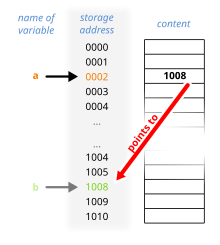
Back مؤشر (برمجة) Arabic گؤستهریجیلر (بیلگیسایار بیلیمی) AZB Указател (програмиране) Bulgarian Punter (programació) Catalan Ukazatel (programování) Czech Peger Danish Zeiger (Informatik) German Δείκτης (πληροφορική) Greek Adresmontrilo Esperanto Puntero (informática) Spanish
This article needs additional citations for verification. (April 2018) |
I do consider assignment statements and pointer variables to be among computer science's "most valuable treasures."
Donald Knuth, Structured Programming, with go to Statements[1]

In computer science, a pointer is an object in many programming languages that stores a memory address. This can be that of another value located in computer memory, or in some cases, that of memory-mapped computer hardware. A pointer references a location in memory, and obtaining the value stored at that location is known as dereferencing the pointer. As an analogy, a page number in a book's index could be considered a pointer to the corresponding page; dereferencing such a pointer would be done by flipping to the page with the given page number and reading the text found on that page. The actual format and content of a pointer variable is dependent on the underlying computer architecture.
Using pointers significantly improves performance for repetitive operations, like traversing iterable data structures (e.g. strings, lookup tables, control tables and tree structures). In particular, it is often much cheaper in time and space to copy and dereference pointers than it is to copy and access the data to which the pointers point.
Pointers are also used to hold the addresses of entry points for called subroutines in procedural programming and for run-time linking to dynamic link libraries (DLLs). In object-oriented programming, pointers to functions are used for binding methods, often using virtual method tables.
A pointer is a simple, more concrete implementation of the more abstract reference data type. Several languages, especially low-level languages, support some type of pointer, although some have more restrictions on their use than others. While "pointer" has been used to refer to references in general, it more properly applies to data structures whose interface explicitly allows the pointer to be manipulated (arithmetically via pointer arithmetic) as a memory address, as opposed to a magic cookie or capability which does not allow such.[citation needed] Because pointers allow both protected and unprotected access to memory addresses, there are risks associated with using them, particularly in the latter case. Primitive pointers are often stored in a format similar to an integer; however, attempting to dereference or "look up" such a pointer whose value is not a valid memory address could cause a program to crash (or contain invalid data). To alleviate this potential problem, as a matter of type safety, pointers are considered a separate type parameterized by the type of data they point to, even if the underlying representation is an integer. Other measures may also be taken (such as validation and bounds checking), to verify that the pointer variable contains a value that is both a valid memory address and within the numerical range that the processor is capable of addressing.
- ^ Donald Knuth (1974). "Structured Programming with go to Statements" (PDF). Computing Surveys. 6 (5): 261–301. CiteSeerX 10.1.1.103.6084. doi:10.1145/356635.356640. S2CID 207630080. Archived from the original (PDF) on August 24, 2009.